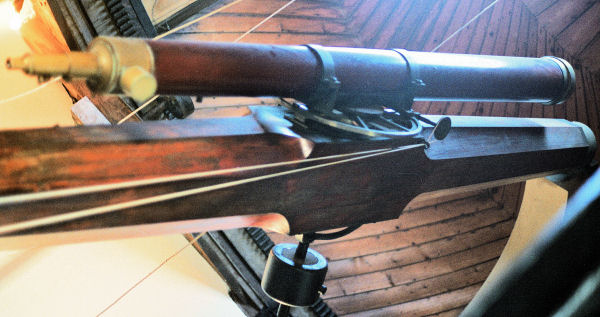|
The Telescope at Abbots Hill, Abbots Langley, 1860s January, 2014 |
|
||||||
Robert Baird-Trotter (trotts1 @t hotmail.com) of Bridgetown, Australia, writes: I purchased an 6.3 inch diameter Merz telescope telescope late in 1989 and I have documentary evidence that suggests is the telescope that was delivered to the Rev. William Rutter Dawes in 1846 and was later sold to "A gentleman, a friend of Admiral Smythe" in 1859. This telescope is a very important telescope related to the History of Astronomy in the first half of the 19th Century in Victorian England.

I know that John Dickinson installed a telescope in his home at Abbots Hill sometime between his retirement and his death and I believe this telescope was the one that once belonged to Rev. William Rutter Dawes and was sold to "A gentleman, a friend of Admiral Smythe" in 1859. Can you confirm the provenance by tracking how it ended up at Abbots Hill and just when it was installed.
I very much doubt that I could confirm the sale of William Rutter Dawes' telescope to John Dickinson, especially as it was probably by private treaty. However you say it was sold to "A gentleman, a friend of Admiral Smythe" in 1859, and the evidence I have found makes it certain that John Dickinson could have been described in that way. John would have regularly attended the same London meetings as Admiral Smyth. There can also be little doubt that John would have taken the best advice and brought the best equipment available, and who better to ask than Admiral Smyth.
The Manchester Courier of 25th May 1869 [British Newspaper Archives] reported on a meeting of the Royal Geographical Society in London the previous day at which details were given of deceased members including Mr John Dickinson, Fellow of the Royal Society, for many years a fellow of this society, had at the time of his decease on the 11th of January last, nearly attained the advanced age of 87. Actively engaged in business pursuits during by far the greater part of his long life, he still took a keen interest in various branches of science, and more especially those of astronomy and geography, having constructed an observatory at his country home of Abbots Hill, in Hertfordshire. ...
Admiral Smyth - William Henry Smyth (1788-1865) was not only a Fellow of the Royal Astronomical Society, but also a Fellow of the Royal Society, and a Fellow of the Royal Geographical Society. It may not be relevant because I suspect they both had London homes, but as Admiral Smyth lived at Stone, near Aylesbury, both he and John Dickinson could well have taken the same trains to and from London to attend meetings of the various societies they both belonged to.
Of course this is not proof and Bob commented:
There is much evidence that Smyth and Dickinson and no doubt Dawes and others often met at society and social events and knew each other well. The problem facing my research is that as a result of this common and frequent social intercourse that almost nothing was written down. It is the exception that is noted, not the common. However, there must be a note somewhere in one of the "friends" circle of acquaintances who may have noted that Dickinson suddenly acquired a "Nice Merz telescope of 6.3" aperture"!
Another problem is where could this information reside today? The RAS or maybe the BAA Archives or in the personal literature of any one of Dickensons friends. Maybe something will be in the Archives of the successors of Dickinson & Co (if the records still exist) or if anyone in the company gives a damn.
The problem is that there may be no surviving unambiguous records. Many of the enquiries I get on this site arise because there are no surviving records of someone's ancestor's birth or baptism - and hence no record of their parents. Of course the circles in which John Dickinson moved are more likely to include people who kept diaries and correspondence. I can't comment on records of societies of the Royal Astronomical Society (founded 1820) or the British Astronomical Association (which of course was not founded until 1890) - but a note or two on possible Hertfordshire Sources.
-
Quite a few documents relating to the paper making business survive - these are associated with The Paper Trail at Apsley but are held in the Hertford Museum. A look at the online catalogue shows that 99% of the documents are directly related to the business and irrelevant to your enquiry, and none relate (at the catalogue level) to John Dickinson's house, Abbots Hill, where the observatory was built. However there is one item (
I have just noted that the page on John Dickinson on the Dacorum History Digest includes the words "As a man of science he had an observatory built as an addition to the house. On first using it he failed to see anything, Evans tells us that he swore loudly and never entered the observatory again. He had in fact left the lens cap on." This text was produced in connection with The Paper Trail. This sounds a little unlikely but we must remember John Dickinson's age and it may be that in his old age his sight was failing and at the end he was unable to make full use of a telescope.
The previous note refers to Sir John Evans, the archaeologist and nephew, son-in-law, and employee of John Dickinson. I don't know the location of any Evans family records but he clearly knew about the telescope and may have actually looked through it! Possibly the best contact for any letters, diary notes, etc.
November 2014
F. G. Kitton (1856-1904), as curator of St Albans Museum, purchased Sir John Evans' collection of books, manuscripts and drawings for the museum.

